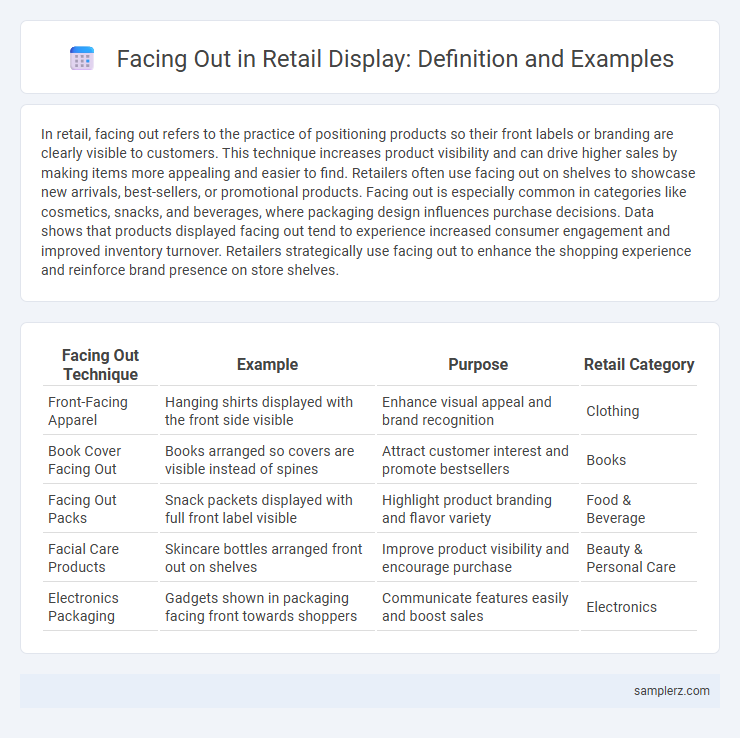In retail, facing out refers to the practice of positioning products so their front labels or branding are clearly visible to customers. This technique increases product visibility and can drive higher sales by making items more appealing and easier to find. Retailers often use facing out on shelves to showcase new arrivals, best-sellers, or promotional products. Facing out is especially common in categories like cosmetics, snacks, and beverages, where packaging design influences purchase decisions. Data shows that products displayed facing out tend to experience increased consumer engagement and improved inventory turnover. Retailers strategically use facing out to enhance the shopping experience and reinforce brand presence on store shelves.
Table of Comparison
| Facing Out Technique | Example | Purpose | Retail Category |
|---|---|---|---|
| Front-Facing Apparel | Hanging shirts displayed with the front side visible | Enhance visual appeal and brand recognition | Clothing |
| Book Cover Facing Out | Books arranged so covers are visible instead of spines | Attract customer interest and promote bestsellers | Books |
| Facing Out Packs | Snack packets displayed with full front label visible | Highlight product branding and flavor variety | Food & Beverage |
| Facial Care Products | Skincare bottles arranged front out on shelves | Improve product visibility and encourage purchase | Beauty & Personal Care |
| Electronics Packaging | Gadgets shown in packaging facing front towards shoppers | Communicate features easily and boost sales | Electronics |
Definition of Facing Out in Retail Display
Facing out in retail display refers to the technique of positioning products so their front packaging is fully visible to customers, enhancing visual appeal and brand recognition. This method improves product accessibility and encourages impulse buying by making items easier to identify and select. It plays a crucial role in store merchandising strategies aimed at maximizing shelf impact and sales performance.
Importance of Facing Out for Product Visibility
Facing out on retail displays significantly enhances product visibility by showcasing the front packaging, which attracts customer attention more effectively than edge or spine placements. This technique increases the likelihood of product recognition and impulse purchases, driving higher sales and improving brand presence on crowded shelves. Proper facing out aligns with consumer behavior insights, ensuring products are easily identifiable and accessible, which boosts overall store performance.
Types of Products Commonly Faced Out
In retail displays, perishable goods such as fresh produce, dairy, and bakery items are commonly faced out to enhance visibility and encourage immediate purchase. Packaged goods like snacks, cereals, and beverages use facing out to maintain brand consistency and shelf organization. Seasonal and promotional products also benefit from facing out to attract customer attention and drive sales during specific time frames.
Step-by-Step Process of Creating Facing Out Displays
Create facing out displays by selecting high-demand or visually appealing products, ensuring they are positioned at eye level to maximize customer engagement. Remove excess inventory and arrange items so the product front faces outward, maintaining neatness and accessibility. Regularly rotate displays based on sales data and seasonal trends to keep the presentation fresh and drive continuous interest.
Best Practices for Effective Facing Out Techniques
Using consistent product alignment and clearly visible pricing ensures optimal retail facing out techniques, boosting customer engagement and sales conversion. Prioritizing eye-level placement for high-demand items maximizes product visibility and encourages impulse buying. Regularly updating displays based on inventory turnover and seasonal trends maintains freshness and relevance in the retail environment.
Examples of Successful Facing Out in Grocery Stores
Grocery stores increase sales by facing out products like organic snacks and specialty sauces, which enhances visibility and attracts health-conscious customers. Brands such as Amy's Kitchen and Trader Joe's effectively use facing out techniques to highlight unique packaging and key nutritional information. Strategic product placement on eye-level shelves encourages impulse buys and strengthens brand recognition in competitive retail environments.
Comparing Facing Out vs. Stacking Displays
Facing out displays enhance product visibility by presenting the front of items directly to customers, increasing engagement and purchase intent compared to stacking displays, which arrange products in piles with sides or backs facing out. Research shows facing out methods can boost sales by up to 40% due to easier product recognition and appeal. Retailers prioritizing shelf space optimization often combine facing out with strategic placement to maximize consumer interaction and brand prominence.
Impact of Facing Out on Customer Purchase Decisions
Facing out products on retail displays significantly enhances product visibility, making key features and brand labels easily recognizable to customers. This strategic placement increases the likelihood of impulse purchases by drawing attention to new or promotional items. Studies indicate that facing out can boost sales by up to 30%, as customers are more inclined to engage with prominently displayed products.
Visual Merchandising Tips for Facing Out Products
Facing out products in retail displays enhances visibility by showcasing the product's front, making it easier for customers to identify and engage with key items. This technique increases product appeal and encourages impulse purchases by highlighting brand logos, vibrant packaging, and essential features. Optimal facing out strategies involve consistent alignment, sufficient lighting, and strategic placement at eye level to maximize shopper interaction and sales conversion.
Common Mistakes to Avoid When Facing Out Products
Failing to maintain consistent product alignment and neglecting proper spacing are common mistakes that reduce visual appeal and customer engagement in retail displays. Overcrowding shelves or mixing unrelated items disrupts product visibility and confuses shoppers, ultimately impacting sales. Regularly rotating facing out merchandise and ensuring labels face forward enhances brand recognition and simplifies the shopping experience.

example of facing out in display Infographic
 samplerz.com
samplerz.com